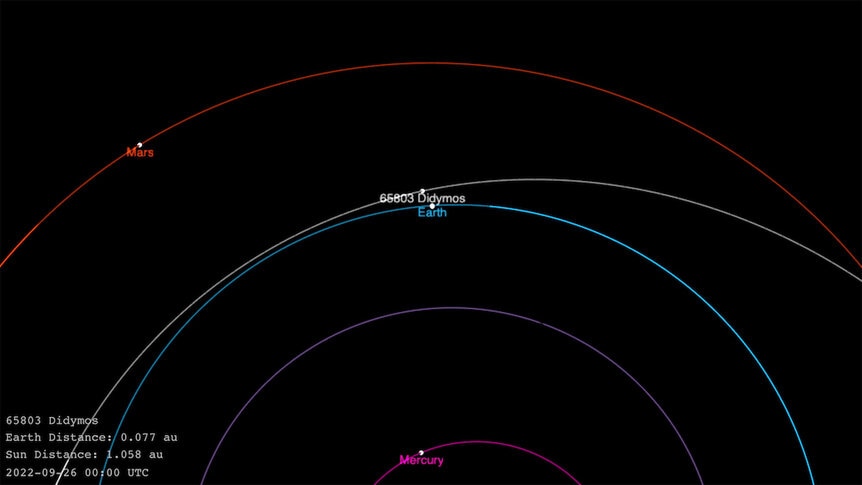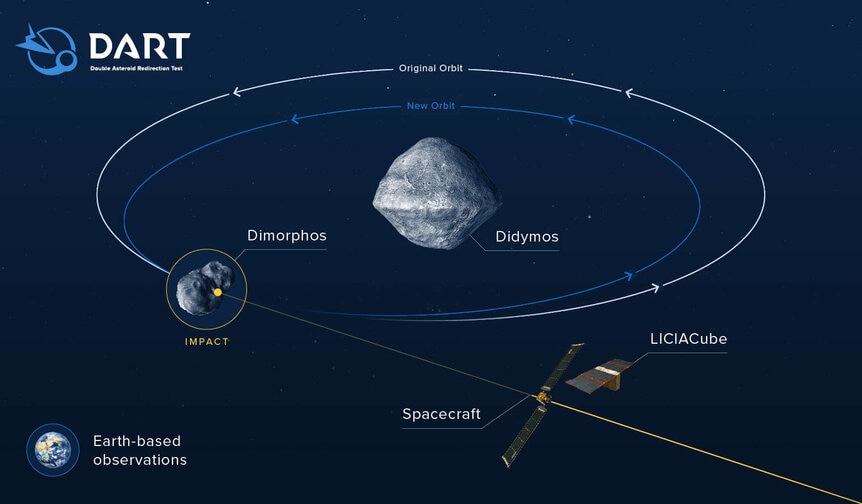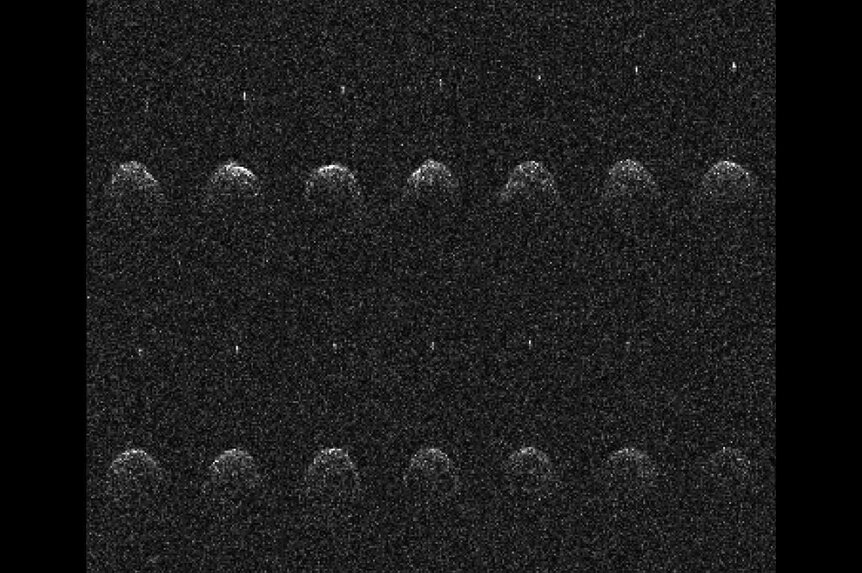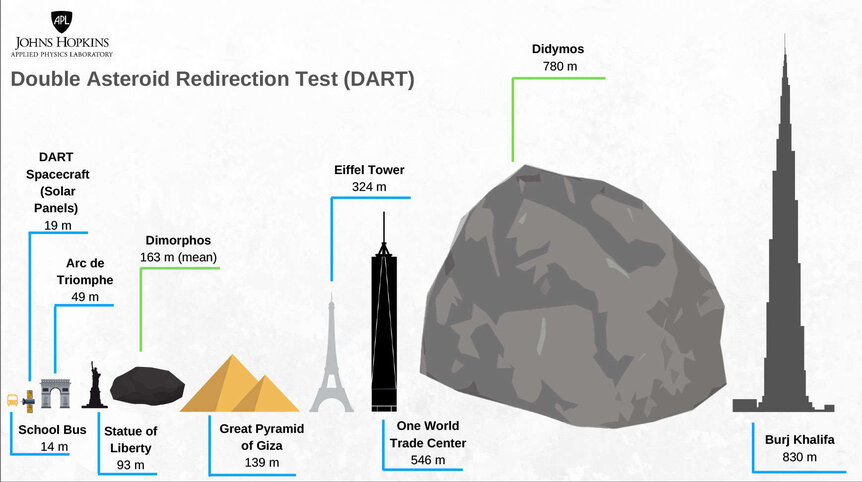Tonight, NASA's DART will slam into an asteroid at 24,000 kph
NASA's hoping for a DART bullseye.

Tonight, if all goes well, NASA’s Double Asteroid Redirection Test — or DART — mission will slam into a tiny asteroid moon at nearly 24,000 kilometers per hour, blasting out a cloud of debris, creating a flash of light visible across the solar system, and changing the velocity of the asteroid by less than a millimeter per second… which is tiny, but significant.
Impact is planned for 23:14 UTC tonight, which is 7:14 p.m. ET. The flash won’t be visible by eye, but may be observable in small telescopes — see my caveats below. It will be observed by professional astronomers across the planet and by observatories above and beyond it, too.
The point? To see if hitting an asteroid at high speed is possible, to test the mechanics and engineering of it, and to hope that, if one day we see a space rock with our number on it, this method can be employed to prevent Earth from having a Very Bad Day.
Note: To be clear, the asteroid will be over 11 million kilometers from Earth when it’s hit, which is far too far away to be of any danger to us. The debris created will mostly be dust, and any chunks too small and far away to be a threat. There has been some fearmongering over this event, because of course there has, but there’s no truth to it. We’ll be OK.
Asteroids are debris left over from the formation of the solar system, chunks of rock and ice and, in some cases, metal that for the most part orbit the Sun between Mars and Jupiter. Some, however, have orbits that bring them close to Earth, and, over time, could eventually hit us. That’s not necessarily a problem if they’re small, but when they get to around 100 meters in size that spells big trouble. They are moving so quickly — dozens of kilometers per second, so in some case more than 100,000 km/hr — that the energy of impact is huge. It can easily dwarf a nuclear weapon, and if the asteroid is big enough it can be larger than the combined nuclear arsenal of every nation on Earth.
That’s a very big problem indeed. Just ask the dinosaurs… which you can’t, for obvious reasons.
The difference between us and the dinosaurs is that we have the science of astronomy and a space program. Astronomers are cataloguing potentially dangerous asteroids, and with rockets there’s something we may be able to do about them.
And that’s the reasoning behind the DART mission. If an asteroid is headed toward Earth and we have a reasonable amount of lead time, we can launch a mission with a space probe that can hit the asteroid, hard, and change its trajectory. The amount of change doesn’t have to be very big if there’s enough time before impact; even a centimeter per second could do the trick, since this could deflect the asteroid by enough to miss us after a few years’ time.
We’ve impacted a space object once before: Comet Tempel 1 with the Deep Impact probe on July 4, 2005. The primary purpose, though, wasn’t to move the comet but to eject enough material to see what was under the surface.
DART is different. It’s a boxy spacecraft a little over a meter on a side, so about the size of a big clothes washer — not including the two solar arrays, which are 8.5 meters long. It’s a pretty simple machine as these things go. It has a handful of sensors to track the stars and the Sun for navigation, and a camera that will image the asteroid and help keep the spacecraft centered on its target. It uses ion engines for fine-tuning the maneuvering.
The target is interesting. A single asteroid orbiting the Sun would make for a fine target, but the problem is measuring the change in its velocity after impact. It’s hard to get an exacting enough observation to do this. Instead, scientists were clever: They picked the small moon of a binary asteroid. The orbit of the moon can be very precisely determined, since it just involves timing how long it takes to orbit any changes, even a tiny one, can be seen.
They chose the asteroid Didymos, an 800-meter-wide rock on an orbit that takes it pretty close to Earth, sometimes less than ten million kilometers. That’s too far to be a danger, but close enough that we can get good observations of it. Didymos is orbited by a smaller asteroid called Dimorphos — Didymos means “twin” in Greek, and Dimorphos means “having two forms,” which represents the orbit changing after impact. The moon is only 170 meters across and orbits a little over a kilometer away from its primary.
The impact will change the orbital velocity of Dimorphos by roughly 0.4 mm/sec, a tiny amount indeed. This will change its 11.9-hour orbital period by about 10 minutes, which is enough to measure. In fact ESA will be launching a follow-up mission called Hera that will visit the system in 2027 and nail down the exact change.
The DART spacecraft will have a mass of about 570 kilograms upon impact, and will be moving at 6.6 kilometers per second relative to the asteroid. The kinetic energy of the impact will be about the equivalent of three tons of TNT exploding, so it should make a decent flash. For comparison, the Deep Impact collision in 2005 was easily visible via telescope, doubling the comet’s usual brightness.
The impact is expected to blast out a lot of debris as well, though how much isn’t clear. A paper recently published estimated it could be as much as 5,700 cubic meters of material, equivalent to a cube 18 meters on a side, the size of a four-story building. They estimate the total brightness of the plume will reach magnitude 6.5, which is easily visible by binoculars — however, the light will be spread out over the plume, so it’s unclear how easy it’ll be to see. I would bet that small telescopes will detect it, though, and it’ll be fun to see everyone’s observations.
Hubble and JWST will observe the asteroid after the impact, and the Lucy spacecraft on its way to Jupiter will be taking a look as well.
The Italian Space Agency has built a small Cubsat called LICIACube that was recently deployed by DART and is following along; it will observe both the impact and the plume from up close. DART itself will be sending images back to Earth as it approaches; the final image will be taken just a couple of seconds before impact and should show details less than a meter across on the surface. Those images will be something to see.
The events of the day will be carried live on NASATV, and you can watch there as well as on Twitter and YouTube. I’ll be on Twitter tweeting info as I get it, too. The Planetary Society has a page with more info, and the Applied Physics Lab at Johns Hopkins University — the mission’s home institute — has an excellent overview as well.
Gianluca Masi of the Virtual Telescope Project will be observing and streaming the impact live, too. I’ll definitely have a tab open to that!
If this works, it will be a huge step forward in mitigating asteroid impacts. I’ve spent a lot of time over the past couple of decades thinking and writing and talking about this threat — I literally wrote a book about it, or at least a chapter of a book about it — and if DART’s aim is true, I know I’ll rest just a little bit easier tonight.































